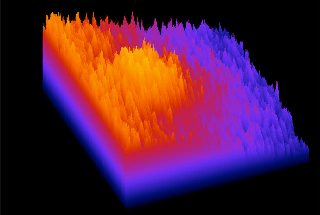Oct 27 2015
Physicists from Rice University and the University of Texas at Austin have found a new recipe for using intense lasers to create positrons — the antiparticle of electrons — in record numbers and density.
 This 3-D contour map of the positron signal for one of the laser shots shows the positron signal strength relative to the pixel-level background noise in the detector. Credit: E. Liang/Rice University
This 3-D contour map of the positron signal for one of the laser shots shows the positron signal strength relative to the pixel-level background noise in the detector. Credit: E. Liang/Rice University
In a series of experiments described recently in the online journal Scientific Reports published by Nature, the researchers used UT’s Texas Petawatt Laser to make large number of positrons by blasting tiny gold and platinum targets.
Although the positrons were annihilated in a fraction of a microsecond, the experiments have implications for new realms of physics and astrophysics research, medical therapy and perhaps even space travel, said Rice physicist Edison Liang, lead author of the study.
“There are many futuristic technologies related to antimatter that people have been dreaming about for the last 50 years,” said Liang, the Andrew Hays Buchanan Professor of Astrophysics. “One is that antimatter is the most efficient form of energy storage. When antimatter annihilates with matter, it becomes pure energy. Nothing is left behind, unlike in fusion or fission or chemical-based reactions.”
With laser pulses as short as 130 femtoseconds (one femtosecond equals one-quadrillionth of a second), and peak intensity reaching almost 2 billion-trillion watts per square centimeter, the Texas Petawatt Laser is one of the world’s most intense short-pulse, high-energy lasers. In experiments that began in 2012, the Rice-UT team led by Liang completed more than 130 successful laser shots using gold and platinum targets.
“The physical conditions created in our experiments are more extreme than in previous experiments,” Liang said. “Antimatter has been created in accelerators for many decades, but the key difference here is that the laser pulses are very short and ultra intense. The density of antimatter created is high because it’s all concentrated in a tiny amount of space.”
In some shots, the team found they produced jets of particles that included about half as many positrons as electrons. Liang said a high ratio of positrons to electrons is important because physicists would like to produce a mixture that approaches a neutral “pair plasma” with equal numbers of positrons and electrons.
"Pair-dominated plasmas of positrons and electrons are fixtures in the universe,” he said. “They are believed to exist in the winds of pulsars, jets of quasars and gamma-ray bursts, and they are also thought to dominate the universe in the milliseconds following the Big Bang. We hope to use this laboratory platform to simulate some of those phenomena.”
Liang said the group would ultimately like to both create a dense pair-dominated plasma and find a way to capture it in a magnetic bottle for further study.
“Once you trap pure antimatter, the antiparticles can live a long time as long as they don’t touch any matter,” he said. “Since the 1950s, the Air Force, NASA and others have been talking about using antimatter for space travel. In space, weight is the key factor in determining how much fuel you can take with you.
Under the right conditions, positrons and electrons can pair up and orbit one another without touching or annihilating themselves. This paired arrangement, which behaves like a hydrogen atom with almost no mass, is known as positronium.
“But my main interest, which I’ve been concerned with for about 25 years, is to create a very high concentration of antimatter in a very small volume. We want to create a new form of quantum matter, a Bose-Einstein condensate (BEC), of antimatter. That is a really new domain of quantum physics that we could explore.”
A BEC is a collection of atoms or particles that are cooled to such low temperatures that their behavior is dictated by the laws of quantum mechanics. In a BEC, thousands of individual particles act collectively, marching in lock step as if they were a single entity.
“If we have a very large concentration of electrons and positrons, we could imagine making a BEC,” he said. “The beauty of positronium is that it is so light, it can actually become a BEC at relatively mild temperatures — about the temperature at which you would store liquid helium (minus 452 degrees Fahrenheit).”